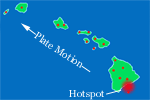Why is Olympus Mons so big?

 The main difference between the volcanoes on Mars and Earth is
their size; volcanoes in the Tharsis region of Mars are 10 to 100
times larger than those anywhere on Earth. The lava flows on
the Martian surface are observed to be much longer, probably a
result of higher eruption rates and lower surface gravity.
The main difference between the volcanoes on Mars and Earth is
their size; volcanoes in the Tharsis region of Mars are 10 to 100
times larger than those anywhere on Earth. The lava flows on
the Martian surface are observed to be much longer, probably a
result of higher eruption rates and lower surface gravity.
Another reason why the volcanoes on Mars are so massive is
because the crust on Mars doesn't move the way it does on Earth.
On Earth, the hot spots remain stationary but crustal plates are
moving above them. The Hawaiian islands result from the
northwesterly movement of the Pacific plate over a stationary
hotspot producing lava. As the plate moves over the hotspot,
new volcanoes are formed and the existing ones become extinct.
This distributes the total volume of lava among many volcanoes
rather than one large volcano. On Mars, the crust remains stationary
and the lava piles up in one, very large volcano.
For more on Olympus Mons:
3-D image of Olympus Mons (you'll need 3-D glasses!)
Earth and Space Network
University of Michigan